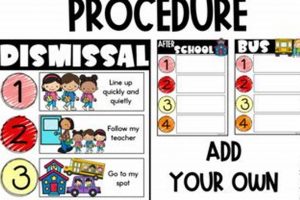Early science education typically introduces fundamental concepts in physics, chemistry, biology, and Earth science through hands-on activities and experiments. Children might explore the life cycle of a butterfly, build simple machines, or investigate the properties of different materials. These initial experiences cultivate curiosity, critical thinking, and problem-solving skills.
A strong foundation in scientific principles fosters a deeper understanding of the natural world and empowers informed decision-making. Historically, early science education has evolved from nature study and object lessons to more inquiry-based learning approaches that emphasize experimentation and the scientific method. This pedagogical shift reflects a growing recognition of the importance of fostering scientific literacy from a young age, preparing future generations for a world increasingly shaped by scientific advancements and technological innovation.
This discussion will delve into the core components of a robust early science curriculum, exploring best practices for teaching and learning, addressing common challenges, and highlighting innovative approaches to ignite a passion for scientific exploration in young learners.
Tips for Effective Early Science Education
Cultivating a strong foundation in science during the elementary years requires thoughtful planning and engaging pedagogy. The following tips offer guidance for educators and caregivers seeking to create enriching learning experiences.
Tip 1: Prioritize Hands-on Activities: Active engagement with scientific concepts through experiments and investigations promotes deeper understanding and retention. Building a simple circuit or dissecting a flower allows learners to apply theoretical knowledge in practical contexts.
Tip 2: Encourage Inquiry-Based Learning: Foster curiosity and critical thinking by posing open-ended questions and encouraging students to formulate their own hypotheses and design investigations to test them.
Tip 3: Integrate Science Across the Curriculum: Connect scientific principles to other subjects, such as mathematics, language arts, and social studies, to demonstrate the relevance of science in everyday life. Calculating the area of a garden bed or writing a report about a local ecosystem reinforces interdisciplinary connections.
Tip 4: Utilize Real-World Examples: Relate scientific concepts to real-world phenomena to enhance understanding and engagement. Discussing the water cycle in the context of local weather patterns or exploring the principles of leverage with simple machines found in the classroom makes learning more meaningful.
Tip 5: Provide Opportunities for Collaboration: Group projects and discussions encourage communication, teamwork, and peer learning. Students can share their observations, analyze data collectively, and learn from each other’s perspectives.
Tip 6: Embrace Outdoor Learning: Nature provides a rich laboratory for scientific exploration. Field trips to local parks, nature reserves, or even school gardens offer opportunities to observe ecosystems firsthand and collect data in authentic settings.
Tip 7: Differentiate Instruction: Recognize that learners progress at different paces and tailor instruction to meet individual needs. Providing tiered activities or offering varied levels of support ensures that all students can access and engage with the material.
By implementing these strategies, educators can create dynamic learning environments that foster a lifelong love of science and equip young learners with the skills and knowledge necessary to thrive in an increasingly complex world.
These tips serve as a starting point for a broader conversation about the future of early science education and the importance of investing in the next generation of scientific thinkers and innovators.
1. Foundational Concepts
Foundational concepts in elementary school science form the bedrock for future scientific understanding. These core ideas, introduced in simplified forms, provide a framework upon which more complex scientific principles can be built. A clear grasp of these initial concepts is crucial for developing scientific literacy. For instance, understanding the water cycle in elementary school prepares students to later grasp more nuanced concepts like climate change and ecosystem dynamics. Similarly, early exposure to basic physics concepts, like force and motion, lays the groundwork for comprehending more advanced physics principles in later grades. The absence of these foundational concepts can hinder a student’s ability to progress in scientific learning, creating a gap in understanding that widens over time.
These foundational concepts are not merely theoretical; they connect directly to observable phenomena in the everyday world. Learning about the life cycle of a plant, for instance, can be tied to growing a bean sprout in the classroom, providing a tangible link between abstract concepts and real-world processes. Observing the changing states of water solid, liquid, and gas through simple experiments reinforces the concept of matter and its properties. Such practical applications solidify understanding and foster a deeper appreciation for the scientific principles at play in the world around them. This approach also cultivates critical thinking skills by encouraging students to observe, analyze, and draw conclusions based on evidence.
In conclusion, a robust understanding of foundational scientific concepts is essential for success in later science education. These concepts provide the building blocks for future learning, enabling students to grasp more complex ideas and connect them to real-world experiences. The emphasis on these fundamentals in elementary school science equips students with the necessary tools for scientific inquiry and cultivates a lifelong appreciation for the scientific world. The challenge lies in presenting these concepts in engaging and age-appropriate ways, fostering curiosity and a desire to explore the natural world further. This early groundwork in science education has profound implications, shaping not only individual understanding but also the future of scientific innovation and discovery.
2. Hands-on Exploration
Hands-on exploration forms a cornerstone of effective elementary school science education. Direct interaction with materials and phenomena allows young learners to move beyond abstract concepts and develop a deeper understanding of scientific principles. This active learning approach fosters critical thinking, problem-solving skills, and a genuine appreciation for the scientific process. Engaging multiple senses through tactile, visual, and auditory experiences enhances memory retention and encourages a more profound connection with the subject matter. This section will explore the multifaceted benefits of hands-on exploration in the context of elementary science education.
- Kinesthetic Learning and Engagement
Kinesthetic learning, or learning through physical activity and manipulation of objects, is particularly crucial for young children. Hands-on activities provide opportunities to explore concepts through touch, movement, and experimentation. Building a model of the solar system, for instance, allows students to visualize the relative sizes and positions of planets, while conducting a simple experiment with ramps and toy cars demonstrates the effects of gravity and friction. This physical engagement increases attention spans and makes learning more memorable.
- Development of Scientific Skills
Hands-on exploration provides a natural platform for developing essential scientific skills such as observation, data collection, and analysis. Measuring plant growth over time, classifying rocks by their properties, or observing the behavior of insects in a terrarium encourages careful observation and record-keeping. Analyzing the collected data enables students to draw conclusions and communicate their findings, mirroring the practices of professional scientists.
- Conceptual Understanding and Retention
Abstract scientific concepts can be challenging for young learners to grasp. Hands-on activities provide concrete experiences that solidify understanding and improve retention. Building a simple circuit with batteries, wires, and bulbs, for example, illuminates the concept of electrical flow, while creating a mini-ecosystem in a jar demonstrates the interconnectedness of living organisms. These tangible experiences make abstract ideas more accessible and meaningful.
- Fostering Curiosity and Inquiry
Hands-on exploration nurtures natural curiosity and encourages a spirit of inquiry. The open-ended nature of many hands-on activities allows students to ask their own questions, formulate hypotheses, and test their predictions. Designing an experiment to test different types of soil for plant growth or investigating the properties of various materials fosters a sense of ownership over the learning process and empowers students to become active participants in scientific discovery.
In summary, hands-on exploration serves as a vital bridge between theoretical concepts and practical application in elementary school science. By engaging multiple learning styles, promoting the development of essential scientific skills, and fostering a spirit of inquiry, hands-on activities empower young learners to become active participants in their scientific journey. This approach not only enhances understanding and retention but also cultivates a lifelong love of science and prepares students for future scientific endeavors.
3. Inquiry-Based Learning
Inquiry-based learning represents a pedagogical approach where students develop understanding through exploration, questioning, and investigation. Within elementary school science, this method fosters critical thinking skills, problem-solving abilities, and a deeper understanding of scientific concepts. Rather than passively receiving information, students actively construct knowledge through direct experiences. This approach aligns with the natural curiosity of young learners, transforming the science classroom into a space of exploration and discovery. For instance, instead of simply being told how shadows form, students might investigate the relationship between light sources, objects, and shadow formation through experimentation. This process encourages them to develop their own hypotheses, test predictions, and draw conclusions based on evidence.
The implementation of inquiry-based learning in elementary science classrooms offers numerous benefits. It cultivates a deeper understanding of scientific concepts by connecting theory to practical experience. Students develop essential scientific skills, such as observation, data collection, analysis, and interpretation. Furthermore, inquiry-based learning nurtures scientific literacy, preparing students to engage critically with scientific information and apply scientific reasoning to real-world situations. An example could involve students investigating the properties of different materials to determine which would be most suitable for building a bridge that can withstand a certain weight. This project not only teaches them about material properties but also encourages collaboration, problem-solving, and application of scientific principles to design challenges.
Effectively integrating inquiry-based learning within elementary science curricula requires careful planning and appropriate resources. Educators must create learning environments that encourage questioning, exploration, and collaboration. Providing open-ended investigations, access to age-appropriate materials, and opportunities for students to share their findings are critical. While challenges such as classroom management and time constraints exist, the benefits of fostering genuine scientific understanding and critical thinking skills through inquiry-based learning significantly outweigh these challenges. This pedagogical approach cultivates a lifelong love of science and equips students with the skills they need to thrive in an increasingly complex and scientifically driven world.
4. Scientific Method
The scientific method provides a structured framework for investigation and discovery, playing a crucial role in elementary school science education. Introducing this systematic approach at an early age equips students with essential skills for critical thinking, problem-solving, and understanding the world around them. While simplified for younger learners, the core principles of the scientific method remain consistent: observation, questioning, hypothesis formation, experimentation, data analysis, and conclusion. This framework encourages a shift from rote memorization to active learning, empowering students to become scientific explorers in their own right.
- Observation and Questioning
Cultivating keen observation skills is paramount in early science education. Students learn to identify patterns, notice details, and formulate questions about the natural world. Observing the growth of a plant, for instance, might lead to questions about the factors influencing its development. This initial curiosity forms the foundation for scientific inquiry.
- Hypothesis Formation
Following observation and questioning, students develop testable predictions, or hypotheses. These educated guesses provide a direction for investigation. For example, a student might hypothesize that a plant receiving more sunlight will grow taller than a plant receiving less sunlight. This step encourages critical thinking and the ability to connect cause and effect.
- Experimentation and Data Collection
Designing and conducting experiments to test hypotheses is a central component of the scientific method. Elementary school experiments might involve simple procedures like measuring plant growth under different light conditions or comparing the properties of different materials. Students learn to collect data systematically, emphasizing accuracy and careful observation.
- Analysis and Conclusion
Analyzing collected data allows students to draw conclusions about their hypotheses. Comparing the growth rates of plants in different light conditions, for instance, helps students determine whether their initial hypothesis was supported or refuted. This process reinforces the importance of evidence-based reasoning and the iterative nature of scientific inquiry.
Introducing the scientific method in elementary school provides a fundamental framework for understanding how scientific knowledge is generated and refined. By engaging in this process, students not only learn specific scientific concepts but also develop critical thinking skills, problem-solving abilities, and a deeper appreciation for the scientific endeavor. These skills extend beyond the science classroom, equipping students to approach challenges systematically and make informed decisions in various aspects of their lives. This early exposure to the scientific method lays a strong foundation for future scientific learning and fosters a lifelong curiosity about the natural world.
5. Real-World Connections
Connecting scientific concepts to real-world contexts is crucial for effective elementary school science education. This approach bridges the gap between abstract principles and tangible experiences, making learning more relevant and engaging. Relating classroom lessons to everyday phenomena strengthens understanding and fosters a deeper appreciation for the practical applications of science. Cause and effect relationships become clearer when explored through real-world examples. For instance, studying the water cycle can be connected to observable weather patterns, explaining the formation of rain or snow. Examining simple machines can be linked to everyday tools, demonstrating how levers, pulleys, and inclined planes facilitate tasks. This connection transforms theoretical knowledge into practical understanding, empowering students to apply scientific principles to their surroundings.
Real-world connections serve as a vital component of elementary school science due to their ability to enhance engagement, promote critical thinking, and foster scientific literacy. When students recognize the relevance of scientific concepts to their lives, their motivation to learn increases. Analyzing the nutritional value of food, exploring the impact of pollution on local ecosystems, or investigating energy-efficient technologies empowers students to become informed citizens capable of addressing real-world challenges. Furthermore, these connections illustrate the interconnectedness of scientific disciplines, demonstrating how biology, chemistry, physics, and Earth science intersect in everyday phenomena. Investigating the growth of a garden, for example, can connect concepts from biology (plant life cycles), chemistry (soil composition), and Earth science (weather and climate).
Cultivating an understanding of real-world connections in elementary school science has profound implications for students’ future learning and societal contributions. This approach fosters critical thinking skills, enabling students to analyze information, evaluate evidence, and make informed decisions. It also nurtures a sense of responsibility towards the environment and encourages active participation in addressing global challenges. By connecting scientific principles to real-world issues, educators empower students to become agents of change, equipped with the knowledge and skills to create a more sustainable and scientifically informed future. While integrating real-world connections may present challenges in terms of resource availability and curriculum design, the long-term benefits of this approach significantly outweigh the obstacles.
Frequently Asked Questions about Elementary School Science
This section addresses common inquiries regarding the scope, importance, and implementation of science education in elementary school settings. Clarity on these fundamental aspects is crucial for fostering effective learning experiences and cultivating scientific literacy in young learners.
Question 1: What core scientific disciplines are typically introduced in elementary school?
Elementary school science curricula generally introduce fundamental concepts from life science (biology), physical science (physics and chemistry), and Earth science. This foundational exposure provides a broad overview of the natural world and prepares students for more specialized scientific exploration in later grades.
Question 2: Why is science education important in elementary school?
Early exposure to scientific concepts and the scientific method fosters critical thinking skills, problem-solving abilities, and a lifelong appreciation for the natural world. These skills extend beyond the science classroom, equipping students to navigate complex issues and make informed decisions in various aspects of their lives.
Question 3: How can parents support their children’s science learning at home?
Parents can support science learning by encouraging curiosity, facilitating exploration through hands-on activities, and connecting scientific concepts to everyday experiences. Visiting museums, exploring nature, and engaging in science-related discussions at home can significantly enrich a child’s scientific understanding.
Question 4: What are some common misconceptions about elementary school science?
One common misconception is that science education at this level requires specialized equipment or extensive resources. Effective science learning can occur through simple experiments and observations using readily available materials. Another misconception is that science is a collection of facts to be memorized, rather than a dynamic process of inquiry and discovery.
Question 5: How can educators make science engaging and accessible for all learners?
Incorporating hands-on activities, utilizing real-world examples, and providing opportunities for collaborative learning can significantly enhance engagement and accessibility in elementary school science. Differentiated instruction caters to diverse learning styles and ensures that all students can participate and succeed.
Question 6: What role does technology play in elementary school science education?
Technology can enhance science learning through interactive simulations, virtual field trips, and access to a wealth of scientific information. However, it is essential to balance technology use with hands-on experiences and direct observation of the natural world.
Cultivating a strong foundation in science during the elementary years is an investment in future generations. By addressing common concerns and promoting effective pedagogical approaches, educators and caregivers can empower young learners to become scientifically literate and inquisitive individuals, prepared to tackle the challenges and opportunities of a rapidly evolving world.
The following section will explore innovative approaches and future directions in elementary school science education, building upon the foundational principles discussed throughout this article.
Conclusion
Elementary school science education, encompassing foundational concepts in physics, chemistry, biology, and Earth science, plays a critical role in shaping young minds. Through hands-on exploration, inquiry-based learning, and application of the scientific method, students develop essential critical thinking skills, problem-solving abilities, and a deeper understanding of the natural world. Connecting these concepts to real-world applications enhances engagement and fosters scientific literacy, equipping students to navigate complex issues and contribute meaningfully to society. Addressing common misconceptions about resource requirements and pedagogical approaches is crucial for fostering effective learning environments.
The future of scientific innovation and discovery rests upon a strong foundation built in elementary school. Continued emphasis on inquiry-driven, hands-on learning, coupled with real-world connections, will empower future generations to address global challenges and advance scientific understanding. Investing in robust elementary school science programs is an investment in a future where informed decision-making and scientific literacy are paramount.







